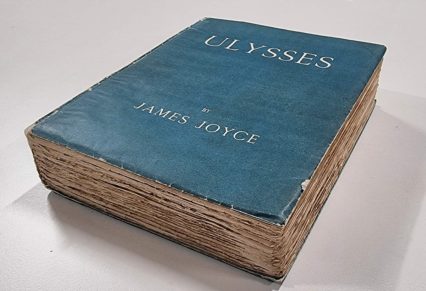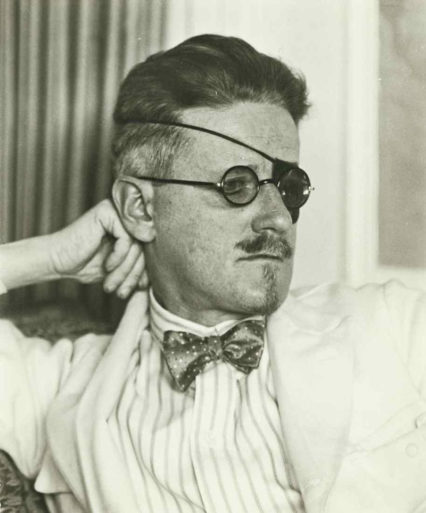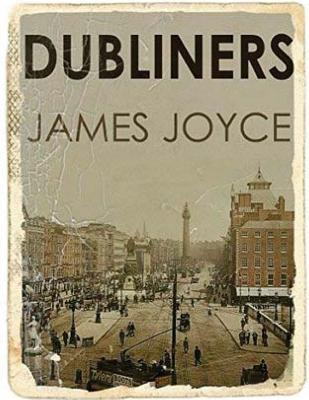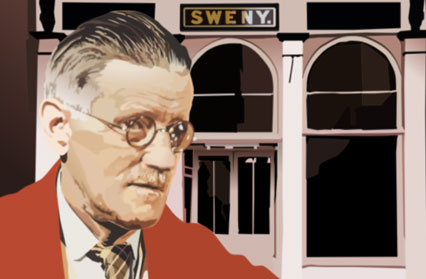Orfhlaith Foyle shares her appreciation for the work of the great Irish writer James Joyce, who is famous for Ulysses and A Portrait of an Artist as a Young Man.
It is considered a rite of passage to read James Joyce, perhaps more so than Beckett or O’Connor or any one of the famous Irish writers. Joyce reads dirty. He reads bold, beating clerical bigotry and Yeatsian beauty into the ground. His prose transforms even the most dismal and banal moments in a life into epiphanies.
He is hailed as the creator of modernist writing, although Dorothy Richardson was the definite pioneer in her thirteen novel sequence Pilgrimage, (1915-1935) and philosopher, William James first used the phrase ‘stream of conscious’ in his book Principles of Psychology (1890).
Joyce’s stream of conscious mirrors the workings of a conscious self and turns its back on the popular, revivalist Celtic narrative of early twentieth century Ireland.
‘Even the most common place, the deadest among the living, may play a part in a great drama.’ (From Joyce’s paper Dream and Life – Jan 20th, 1900)

Ulysses, Joyce’s great novel of one man’s trek through Dublin during one particular day is full of drama in small moments. It plays with fantasy, language and Homer. Leopold Bloom, a cuckold, avoids his wife Molly’s bed because her lover Blazes Boylan has use of it. He crosses paths with Stephen Dedalus, a young man returned from Europe and each of the main characters’ interior monologues carry Joyce’s deliberate intention to create not only a conscious self in literature but a literary self for the city of Dublin.
Joyce was determined to record ‘what a man sees and thinks and what such seeing, thinking, saying does, to what your Freudians call the subconscious.’
Before Joyce wrote Dubliners he wrote varied paragraphs of epiphanies. They were moments of revelation in otherwise minor lives or events. He was concerned with the sense of self in these moments. Dubliners shows the growth of a conscious self and the growth of a city. Joyce despised its narrow, clerical and conservative heart and yet it was this city that illuminated his writing. It was a dedication to the detail in ordinary lives, no matter how foul or seemingly useless, and he saw such lives as beautiful because they were human.
A Portrait of The Artist as Young Man encapsulates Joyce’s belief that life must create life and Joyce is determined to create the conscious of his race.
At the end of Chapter 4, Stephen Dedalus spies a girl wading in the sea and is caught by the pain and the beauty of the future, and of his calling to be an artist. Although there is a small sexual allure, the girl represents the idea of art rather than of a flesh and blood woman, and in this novel, all women are representations of either the artistic soul or of Ireland. All are seen through Stephen’s eyes. The natural explanation for this is that the novel is written as Stephen lives it. It is a portrait of a young man’s selfish and abysmal fear of entrapment as well his fiery devotion to serving his own life. After his youthful conversion to a holy life and the near dalliance with priestly vows, Stephen learns that to sin is to be true to his artistic soul.
Joyce’s religion was art.
In Dubliners, Joyce began to write a new prose for the human experience. All writers desire to create life out of what they see and Joyce described this in a letter to his brother Stanislaus: ‘…I am trying to give people some kind of intellectual pleasure or spiritual enjoyment by converting the bread of everyday life into something that has a permanent life of its own.’ (From My Brother’s Keeper).
Joyce used his own life to make art and he used other people’s lives as well. He sought experiences and created experiences in order to feel what his fictional characters would feel. He was passionate about the ‘self’ and how the ‘self’ grows to adulthood. In Dubliners he uses aspects and experiences of his own life and his family to create the fictional selves that peopled his Dublin.

Joyce was ambitious. To him Dubliner the person and Dublin the city had to be shown to the world and for all his early derision, he had begun to feel more caring of his birth city, but he also felt that the beauty of Ireland, its hospitality and civilisation could not exist in his work without ‘the perverse devil of my literary conscience sitting on the hump of my pen.’
The end story of Dubliners shows this new caring juxtaposed with the main protagonist Gabriel Conroy’s smug irritation as he observes his aunts’ Christmas party in ‘The Dead’.
Like Joyce, he professes a love for Europe, its languages and its culture.
‘And haven’t you your own land to visit,’ continued Miss Ivors, ‘that you know nothing of, your own people, and your own country?’
Joyce suffuses ‘The Dead’ with the living’s love for the dead.
Gabriel Conroy imagines the deaths of his aged aunts, and laments that he has never truly loved while his wife Greta dreams of her dead lover, Michael ‘Sonny’ Bodkin. The dead pass as shades in front of Gabriel and he sees his self, or his soul follow and watch the dead and he is filled with a yearning to love.
Joyce is a great artificer.
The first novel of James Joyce, A Portrait of the Artist as a Young Man creates life as it is read. It is a precursor to Ulysses in language, structure and stream of conscious prose. He uses myths and literature and fashions a life for Stephen Dedalus, at first as impressionistic the way a child’s sight of the world is painterly and amorphous, full of mystery and fear then hardening into reality, conformity and final rebellion. Stephen Dedalus is named after the great artificer in Greek mythology – Daedalus, a supreme craftsman and architect who collected bird feathers and created wings for his and his son Icarus’s escape from Crete. Icarus flew too close to the sun and his wings melted. He drowned. His father flew on.
There are instances where Stephen Dedalus flies close to the sun. His visits to prostitutes while still attending school and his later conversion to saintliness and redemption leads him to the terrible prospect of a life as a priest. A dry papery life, full of subversive violence with gummy, wet mouths and silent vicious habits.
But Stephen is not an Icarus. The growth of the self is fascinating and to create such a self through language and structure is the closet a writer reaches creation. From the first chapter, the reader enters Stephen’s mind. He becomes the ‘baby tuckoo’ in his father’s story. James Joyce leads the reader from outside Stephen to inside Stephen. He changes scenes as Stephen’s mind changes thoughts.

Dublin becomes Hamlet’s Denmark.
A moment before the ghost of the ancient kingdom of the Danes had looked forth through the vesture of the haze-wrapped city. Now at the name of the fabulous artificer, he seemed to hear the noise of dim waves and to see a winged form flying above the waves and slowly climbing the air.
Water, birds, and the image of a young girl wading in the sea deliver Stephen into his own, silent and holy ecstasy. ‘To live, to err, to triumph, to re-create life out of life!’
Stephen feels the call to the artistic life and he struggles to see his way out of Dublin and the confines of his family. He walks to college and his mind aligns his self with artists, writers and philosophers. What is art? What is Beauty, his friends and enemies demand of him. Stephen finally replies by way of Thomas Aquinas, ‘You see that it is the thing which it is and no other thing. The radiance of which he speaks in the scholastic quidditas, the whatness of the thing.’
This ‘whatness of a thing’ is an epiphany in Joyce’s eyes and in Stephen Dedalus’s life. He must be true to his own belief in himself and he will not serve what he no longer believes.
He becomes his own artificer, moving from his conversation with Cranly to writing in a diary. Joyce, the writer shows Stephen creating his own thoughts, ‘Soul free and fancy free. Let the dead bury the dead. Ay. And let the dead marry the dead.’
April 26. Mother is putting my new second hand clothes in order and she prays now that I may learn in my own life and away from my friends what the heart is and what it feels. Amen. So be it.
The novel has shifted from third person narrative to a first person manifesto. Stephen begins to be his own author and creator. What he becomes is left unknown until Ulysses but Joyce has written one portrait of the artist as a young man, a young man heading for Ibsen’s Europe, for a life beyond Dublin and free of everything that made him.
April 27. Old Father, old artificer, stand me now and ever in good stead.
The life of a ‘self’ seen from outside eyes is a life like any other. It lives and sleeps then it dies. In between it may have loved, hated and suffered. All lives are like that. Joyce has gone inside one particular life, a life that is similar to his own, but one he has created because he wants to show that a person’s life and their actual self is worthy to be seen. Its selfishness and abasement, its measly prayers and avaricious lust to soar above itself are as human and as beautiful as what is holy and saintly.
In Dubliners and A Portrait of the Artist as a Young Man Joyce succeeds in creating small lives with interior brilliance, and later in Ulysses, he will create an entire life within one day and become the great literary artificer in the wake of Daedalus.
Find out more about Órfhlaith Foyle here












